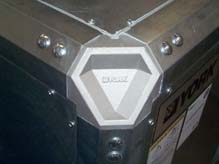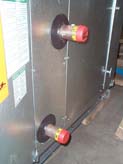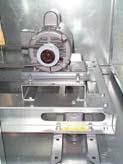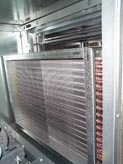
Hello again fellow HVAC professionals;
I have just returned from our annual joint Maine/New Hampshire ASHRAE meeting in Portsmouth. The speaker was Jim Coad, the national President of ASHRAE. Along with his duties with ASHRAE, he is a principal in an engineering firm and on the boards for multiple HVAC equipment manufacturers. He spoke about jobs dating back to 1961, so he has been around. His talk focused on the genesis of vav systems in general and the specific characteristics of today's typical systems. He seemed to me to be a very practical person and favored systems that were simple. We had a great turnout form the Maine contingent. For those that made it, I am sure something was learned. For those who could not, I thought I would summarize what I took away from his talk for you:
Use a dedicated outside air heating & cooling HVAC unit with its own small duct system to introduce outside air to the various required spaces, OR Feed the dedicated outside air HVAC unit supply into the return side of the locally placed recirculating HVAC units.
Work with the architect to control moisture infiltration into the building envelope. Moisture migration is a primary source of building humidity load.
Do not use plenum returns as they will tend to create a negative pressure above the ceiling and draw in moist untreated outside air.
Seal the return air ducts, and treat them as you would the supply side duct work.
He questioned the placement of the moisture barrier in the ceiling/roof area. Apparently, the ceiling moisture barrier is commonly placed above the insulation in the ceiling cavity, allowing moisture to migrate into the occupied building envelope. ( I am not an expert here, I may have incorrectly restated his concern.)
Typical max/min vav systems result in reduced air circulation below a 25% turndown. (i.e. below 75% of max flow, which is quite high)
Shut off a locally placed HVAC unit if the space is satisfied and just feed the space with the dedicated outside air unit.
Fan powered vav boxes are good for keeping up the air rotation in a space, but add a level of complexity that cost money and may be avoidable.
That is a synopsis from memory. I am sure you can read one of his many articles obtained through ASHRAE.
On the equipment side, I have been learning more about York's indoor and outdoor air handlers, and chillers. It seems there is a whole world of features and components to consider on the electrical side when specifying or buying, (or excluding if you are a vendor) of this type of equipment. I will forgo that discussion today and review what I learned about the basic features found or excluded on simple indoor and outdoor double wall air handlers. You will be surprised what you are not getting when you think you are. Click on the pictures to see photos of a York indoor air handler.
 |
 |
|
|
Factory
Sealed
|
Internal
F & B
|
|
 |
||
|
Motor
Drive
|
Prepiped
& Sealed
|
Coil
Frame
|
2" double wall. Sounds straight forward, 2" means 2" right? No. Some manufacturers do not use a double wall floor, leaving insulation exposed in a plenum curb application. Or access doors at the coil are 1" insulated, which is typically the space with the largest temperature differential. How about the unit frame. York insulates the posts by actually stuffing insulation down in there. Others leave it hollow, another source of unit sweating. Some manufacturers modular frame is not covered by the vertical panels, so this uninsulated post is exposed. York's modular vertical post is completely covered by the vertical panels. The only framing you see are the corners, and they are insulated.
IAQ insulated, extended & cleanable drain pan. York's drain pan is insulated with 2" of fiberglass, extends beyond the coil and is fully cleanable and inspectable. Sounds like what someone would expect. The reality is that some drain pans are insulated with 1" rigid board, and sit just under the coil, without extending beyond the coil. Another manufactures drain pan cannot be accessed, inspected or cleaned. The only way to inspect it is to insert a scope through the condensate connection.
Coil replacement. When I think of a coil in an air handler, I think of a coil in its own frame, attached to a bulkhead that you can remove if it breaks. That is York's way of building it. York's unit allows you to remove the return bend cover and get right at the coil. You may be surprised to learn that some manufacturers require you to replace the entire coil segment or largely dismantle the segment to get the coil out. You can imagine how hard it would be to pry apart a segment and slide it out in its entirety.
16 gauge floor on York's indoor ahu's: The standard gauge on some manufacturers equipment is 20 gauge, with 14 gauge as an optional "walking surface" gauge. Some of these indoor air handlers I have quoted are quite large. It seems obvious that at some time, someone is going to need to get in there and walk around. It seems odd to have a "walking surface" optional adder for the floor gauge.
There are other games manufacturers play such as: coil return bend gauges, fin gauges, staggering coils to build a smaller, cheaper box, "mounting" electrical components (and not wiring them), not including a unit base, (needed to trap condensate), no gasketing at the coil casing penetrations, building pipe chases that are small & uninsulated or a pipe chase without a hinged access door.
All the major manufacturers can build and include these basic features. The question is what is important, expected, required. For whatever reason, York has standardized on a construction that includes the above common sense features. They are competitive on a world wide basis with just a few percentage points less market share than the leading manufacturer and well ahead of the next 2 largest competitors. So including great features does not mean the equipment is too expensive for the market, or York would not be right there with the market leader world wide.
As is always the case, quality is hard to define, but easy to see. From what I have seen, York builds a quality piece of equipment. If we are 10% high, it is not that we cost 10% more on a particular job. Rather it is that there are 10 things that York is doing that cost 1% each that others are cutting corners on. I hope the above brief outline piques the interest of some of you out there enough to included us in your specs and speak with us frankly about what is really important to an owner in their air handlers.
We have just received some selection software and catalogs. If any of you do not have updated literature or software, please email or call our office and we will send them out or personally deliver it.
Our featured job this month involves 3 rotating "total energy" wheel heat recovery units by Loren Cook we supplied last summer.

